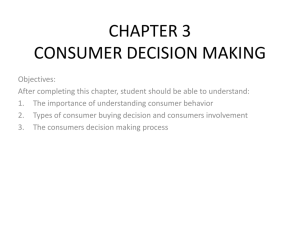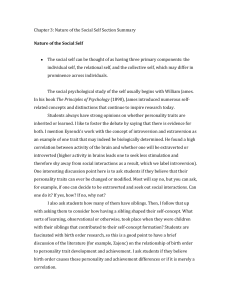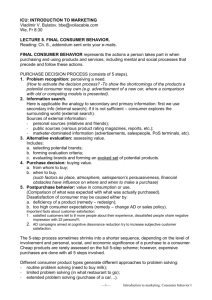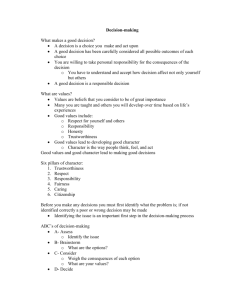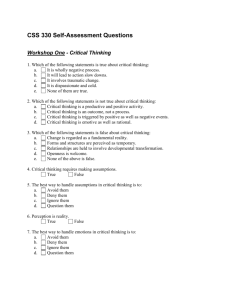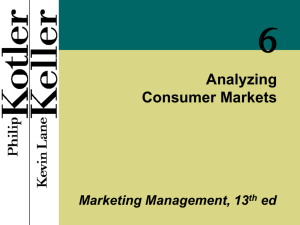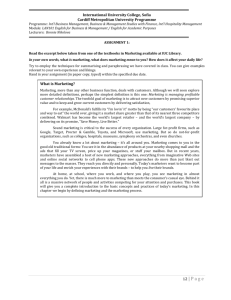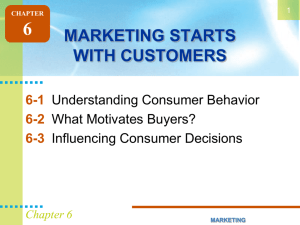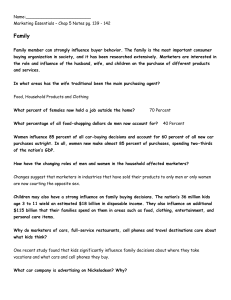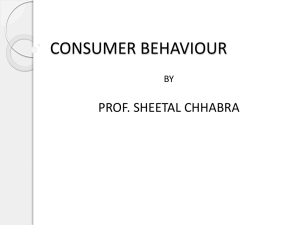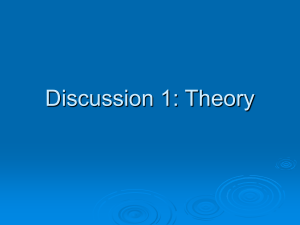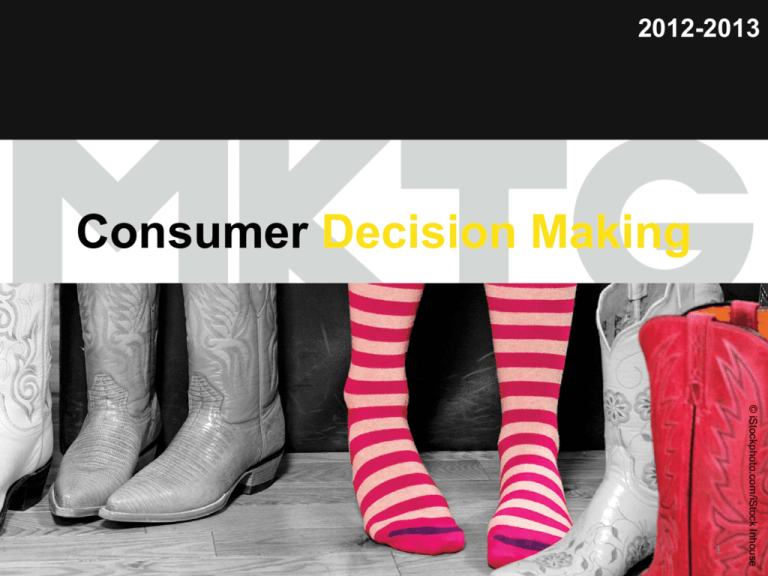
2012-2013
Consumer Decision Making
11
© Nonstock/Jupiterimages
Copyright ©2012 by Cengage Learning Inc. All rights reserved
© iStockphoto.com/iStock Inhouse
Chapter 1
Learning Outcomes
1
Explain why marketing managers should understand
consumer behavior
2
Analyze the components of the consumer decisionmaking process
3
Explain the consumer’s post-purchase evaluation
process
4
Identify the types of consumer buying decisions and
discuss the significance of consumer involvement
2
Understanding Consumer Behavior
Why should Marketing Managers understand
consumer behavior?
Helps marketing managers…
redesign products to meet consumer needs
promote products in an effort to change decisions
helps the government shape public policy by
educating consumers (Affordable Health Care?)
What is it?
The processes a consumer uses to make
decisions when purchasing goods or services
3
What is the Consumer
Decision-Making Process?
Consumer
Decision-Making
Process
A five-step process used
by consumers when
buying goods or services.
How the consumer goes
about addressing needs
4
2
Consumer Decision-Making Process
5
Step 1-Need or Problem Recognition
Need
Recognition
6
Result of an imbalance between
actual and desired states.
2
Needs versus Wants
Needs: Will trigger the decision-making process
Needs: Result from an imbalance between actual and
desired states
Internal stimuli (ex. hunger)
External stimuli (ex. peers)
Wants: Recognition of an unfulfilled
need and a product that will
satisfy that need
http://www.youtube.com/watch?v=TRTkCHE1sS4
7
Step 2-Information Search
Internal Information Search
Recall information in memory
External Information search
Seek information in outside environment
Non-marketing controlled-ex. Friends
Marketing controlled-ex. Radio, TV, Internet
8
2
Step 3-Evaluation of Alternatives
-Evaluative Criteria: How consumers make comparisons--$$$
-Evoked Set: Consumers preferred brands/what is considered
Evoked Set
Analyze product
attributes
Use cutoff criteria
Rank attributes by
importance
Purchase!
9
2
Step 4-Purchase/Product Choice
To buy
or not to buy...
Determines which attributes
are most important
in influencing a
consumer’s choice
10
2
Step 5-Postpurchase Evaluation
Is the consumer satisfied or dissatisfied?
Consumers can reduce dissonance by:
Seeking information that reinforces positive
ideas about the purchase
Avoiding information that contradicts the
purchase decision
Returning the product and revoking
the original decision
Marketers can minimize dissonance through
effective communication with purchasers
11
3
Cognitive Dissonance
Cognitive
Dissonance
12
Inner tension that a
consumer experiences
after recognizing an
inconsistency between
behavior and values or
opinions.
3
Types of Consumer Buying Decisions
and Consumer Involvement
Routine
Response
Behavior
13
Limited
Decision
Making
Extensive
Decision
Making
Less
Involvement:
The amount of time and effortMore
a
Involvement
Involvement
buyer invests in the search, evaluation, and
decision processes of consumer behavior.
4
Routine Response Behavior
14
Little involvement in selection process
Frequently purchased low cost goods
May stick with one brand
Buy first/evaluate later
Quick decision/Heuristics
4
Limited Decision Making
15
Low levels of involvement
Low to moderate cost goods
Evaluation of a few alternative brands
Short to moderate time to decide
4
Extensive Decision Making
16
High levels of involvement
High cost goods
Evaluation of many brands
Long time to decide
May experience cognitive dissonance
4
Influences on
Consumer Buying Decisions
Personality
Social Influences
Cultural Influences
5
17
Personality and Self-Concept
• Personality: a broad concept
– How a person reacts to situations
– Combines psychological makeup and
environmental forces
• Human behavior: depends on self-concept
• Self-concept: how consumers perceive
themselves
– Ideal self-image versus real self-image
– How an individual really wants to be viewed.
– How
18
7
Social Class and Marketing
19
Social class: Measured as a combination
of occupation, income, education & wealth
Indicates which medium to use for
advertising (radio, TV, magazines,
internet)
Helps determine the best distribution for
products (MBZ vs. Honda)
5
Culture is. . .
Pervasive: Everywhere
Functional: Rules & laws
Learned:
From others
Dynamic: Always changing
20
5
Components of Culture
Values
Language
Myths
Customs
Rituals
Laws
Material artifacts
21
5
Subculture
Subculture
A homogeneous group
of people who share
elements of the overall
culture as well as cultural
elements unique to their
own group.
22
5
Social Influences
Reference
Groups
Opinion
Leaders
Family
Members
23
6
Reference Groups
24
They serve as information sources and
influence perceptions.
They affect an individual’s aspiration levels.
Their norms either constrain or stimulate
consumer behavior.
6
Opinion Leaders
…are the first to try new products
and services out of pure curiosity
…can be challenging to locate
Marketers are increasingly using
blogs, social networking, and other
online media to determine and attract
opinion leaders.
25
6
Family Members
Purchase Process Roles
in the Family
Initiators
Influencers
Decision
Makers
Purchasers
Consumers
26
6
Individual Influences
Gender
27
Age
Life Cycle
Personality
Self-Concept
Lifestyle
7
Age & Family Life Cycle Stage
• Consumer tastes in food, clothing, cars,
furniture, and recreation are often age related
• Marketers define target markets according
to life cycle stages such as
– Young singles
– Young married with children
– Middle-aged married w/o children
– Non-traditional households
28
7
Psychological Influences
Perception
Motivation
Learning
Beliefs & Attitudes
29
8
Perception **
30
Selective
Exposure
Consumer notices certain stimuli
and ignores others
Selective
Distortion
Consumer changes or distorts
information that conflicts
with feelings or beliefs
Selective
Retention
Consumer remembers only
that information that
supports personal beliefs
8
Motivation
Maslow’s
Hierarchy
of Needs
A method of classifying human
needs and motivations into five
categories in ascending order of
importance.
As a person fulfills one need, a higher
level need becomes more important.
31
8
Maslow’s Hierarchy of Needs
32

